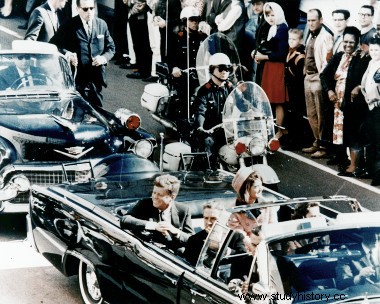The administration of the young US Democratic president John F. Kennedy was marked by numerous events of great media and political scope, whether in the US or in the rest of the world. Among these facts, it cannot be cited:
a) the Bay of Pigs crisis in Cuba.
b) the Vietnam War.
c) the Korean War.
d) the missile crisis in Cuba.
e) the creation of the Alliance for Progress in Latin America.
question 2After the Cuban Revolution of 1959, there was a concern on the part of the USA that other Latin American countries would follow the path of the Caribbean island and establish governments hostile to the Americans. In this context, the President of the United States, John F. Kennedy, decided to formulate an economic aid program known as:
a) Marshal Plan.
b) Warsaw Pact.
c) Alliance for Progress.
d) Washington Consensus.
e) Organization of American States.
question 3(Ufes) In August 1961, at the "Punta Del Este Economic and Social Conference", President John Kennedy presented to Latin American countries the project of the "Alliance for Progress", which foresaw, in general terms, the improvement and the strengthening of democratic institutions, through the self-determination of peoples, the acceleration of the economic and social development of Latin American countries, the eradication of illiteracy and the guarantee to workers of fair remuneration and adequate working conditions. Placing the "Alliance for Progress" in the context of international relations in force in the Post-War period, we can see that its creation was due to the desire of the US government to:
a) to block the sharp outflow of Latin American capital resulting from the massive importation of Japanese consumer goods and the high interest rates paid to the countries belonging to the "Warsaw Pact" on account of loans taken out in the 1950s.
b) contain the advance of revolutionary movements in Latin America, thus reaffirming the leadership exercised by the USA on the continent, in a context of worsening of the Cold War due to the Cuban Revolution.
c) divert, to Latin America, part of the investments foreseen in the "Global Plan for Afro-Asian Decolonization", due to the socialist revolutions in Angola and Mozambique, which made the US position in Africa unsustainable.
d) to prevent the Federal Republic of Germany, a socialist-oriented country, from signing agreements with the aim of transplanting nuclear technology to the Third World, as had happened in Brazil under the JK government.
e) rehabilitate diplomatic agreements between the US and other Latin American countries, which had been broken when US troops invaded Honduras and Ecuador, thus strengthening the OAS.
question 4See the photo below:

The photograph of John F. Kennedy and his wife, Jacqueline Kennedy, was taken moments before his assassination by a gunman, who was in a building located on the way through which the former US president would parade in the city of Dallas, Texas. . The cause of his death, despite numerous uncertainties, can be attributed to:
a) to its racist position.
b) its defense of rapprochement with the USSR.
c) its removal from Latin American countries.
d) the attempted invasion of the Bay of Pigs, after the Cuban Revolution.
e) its attempt to expand civil rights, especially for the black population of the USA.
answers Question 1Letter C. The Korean War was not fought during the Kennedy administration, but during the terms of Harry Truman and Dwight Eisenwover.
question 2Letter C. The Alliance for Progress consisted of investments by US companies in Latin American countries, seeking to install industries and exploit the workforce in these places, in addition to trying to isolate the island of Cuba and the USSR from other countries.
question 3Letter B. The US tried to undermine Cuban influence by making economic and social investments, in addition to strengthening ties between the US military and Latin America in order to repress left-wing revolutionary groups.
question 4Letter E. The controversies regarding the John F. Kennedy administration were many, whether in the external scenario or even in the internal scenario. In this last aspect, Kennedy sought to mark his administration with the adoption of laws that expanded social rights and promoted racial integration, which resulted in strong opposition from the most conservative sectors of American society.
